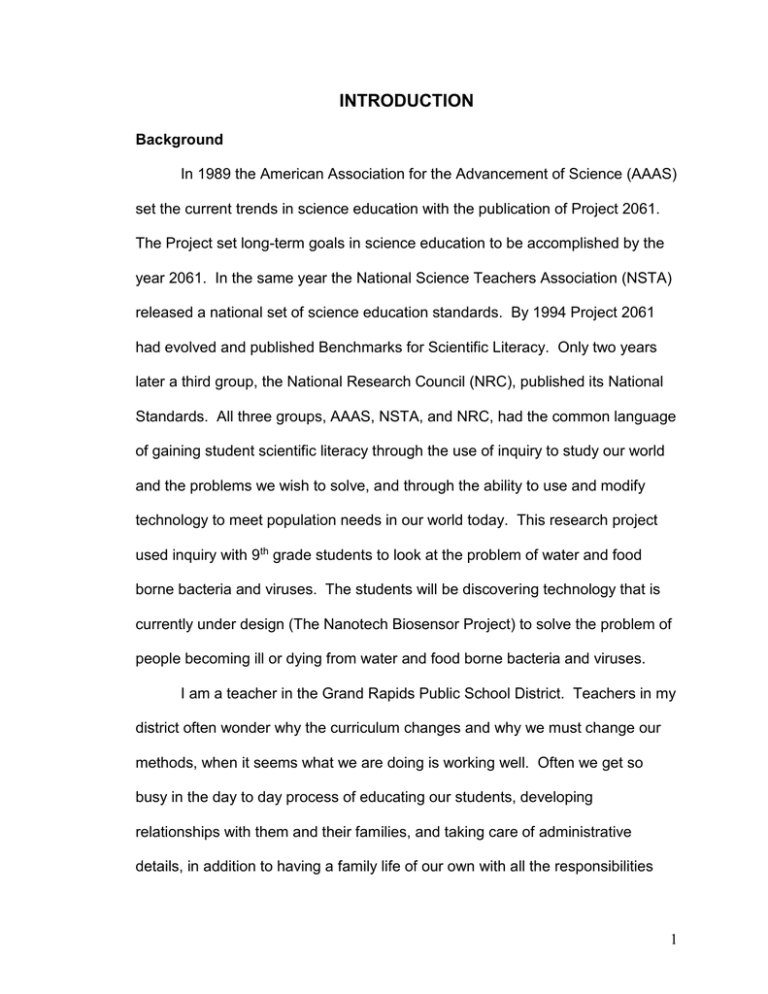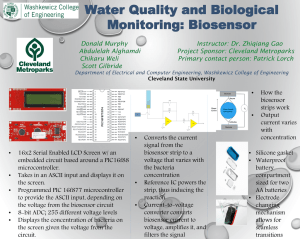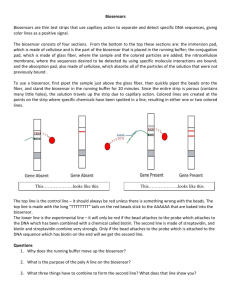2-INTRODUCTION.doc
advertisement

INTRODUCTION Background In 1989 the American Association for the Advancement of Science (AAAS) set the current trends in science education with the publication of Project 2061. The Project set long-term goals in science education to be accomplished by the year 2061. In the same year the National Science Teachers Association (NSTA) released a national set of science education standards. By 1994 Project 2061 had evolved and published Benchmarks for Scientific Literacy. Only two years later a third group, the National Research Council (NRC), published its National Standards. All three groups, AAAS, NSTA, and NRC, had the common language of gaining student scientific literacy through the use of inquiry to study our world and the problems we wish to solve, and through the ability to use and modify technology to meet population needs in our world today. This research project used inquiry with 9th grade students to look at the problem of water and food borne bacteria and viruses. The students will be discovering technology that is currently under design (The Nanotech Biosensor Project) to solve the problem of people becoming ill or dying from water and food borne bacteria and viruses. I am a teacher in the Grand Rapids Public School District. Teachers in my district often wonder why the curriculum changes and why we must change our methods, when it seems what we are doing is working well. Often we get so busy in the day to day process of educating our students, developing relationships with them and their families, and taking care of administrative details, in addition to having a family life of our own with all the responsibilities 1 attached, that we don’t take the time to find out how the world is evolving and how our children need to be prepared for the future. However, all educators need to realize that change is a normal evolutionary process that will happen with or without us. Originating from an internship on the Nanotechnology Biosensor Project led by Dr. Evangelyn C. Alocilja, Biosystems Engineer at Michigan State University in East Lansing, Michigan, the primary objective of the project is to decrease the time it takes to detect a pathogen (such as E.coli, salmonella, bovine viral diarrhea and lysteria) in water, fruits, vegetables, meat, and animal blood samples. The internship with Dr. Alocilja (taken in conjunction with a Masters Thesis through Michigan Technological University) provided a unique opportunity to learn about the project from the scientists by assisting them in their work over the summer of 2006. From learning and working with scientists, my goal was to design and develop inquiry lesson plans for grades seven through twelve based upon the Nanotech Biosensor Project. Implementation and study of student response to the first three lesson plans began in May 2007. Format The lesson plans were written in the 5E Instructional Model, an inquiry format originally developed in the late 1980’s by BSCS, a nonprofit corporation that conducts research and evaluation studies in science education (BSCS 2007). The 5E’s evolved out of the philosophy and work of Johann Herbart and John Dewey in the early 1900’s, Heiss, Obourn, and Hoffmann in 1950, and the Atkin-Karplis Model in the 1960’s (Bybee and others 2006). Embedded within the inquiry based 5E format are the many facets of cognitive development and 2 constructivism that emphasize the students’ active involvement in the process of science. Inquiry-based instruction should engage students in the investigative nature of science (Haury, 1993). Inquiry is multifaceted, rather than one approach to teaching. Inquiry involves the use a variety of skills in a variety of activities. The focus of inquiry is on “the active search for knowledge to satisfy a curiosity” (Haury, 1993) gained from authentic questions generated through experiences of the student (NRC, 2001). As Haury shows through a variety of sources, teaching through inquiry is effective in “fostering scientific literacy and understanding of the science process, vocabulary knowledge and conceptual understanding, critical thinking, positive attitudes toward science, and higher achievement on tests of procedural knowledge” (1993). Because the evidence for an inquiry-based education is well documented, educators will slowly move toward this more effective and exciting approach to science education. Grand Rapids Public Schools has adopted the 5E Framework for educators in the system to use across all curriculums, in all grades (GRPS 2004). The 5E format stands for the five phases of the lesson. The first phase is the engage phase designed to draw the student’s interest and attention to the topic, as often as possible with a real-world component. The second phase is exploration, designed to allow the student an opportunity to pose questions, make observations, examine raw data, build, draw, or “explore” the subject in a variety of ways. The third phase is explanation, which allows the teacher to build off the “explore” phase by answering some of the questions students have come up with during their exploration. The fourth stage is Elaboration, which 3 brings students to the highest levels of thinking by taking their “explore” and “explain” phase experience and knowledge to practical “real world” applications. The final phase is the Evaluation phase where the student’s work is evaluated by the teacher. “Engage” is always done first and “evaluate” is usually done last. However, the middle three stages can be re-sequenced throughout the course of a lesson as often as needed to acquire the learning objectives. Purpose According to the National Science Foundation (NSF) and the National Center for Learning and Teaching Nanoscale Science and Engineering (NCLT), nanoscience is a discipline that is changing our entire marketplace and job force, causing the need for students today to be highly proficient in emerging technologies (NanoEd Resource Portal, 2007). The education community will bear the responsibility in educating our children in the field of nanoscience. One of the challenges in educating our students in the nanosciences is the interdisciplinary nature of the field. Nanoscience is not just physics, chemistry or biology. It’s all of these and other disciplines, on a nanoscale. As the NSF and the NCLT put a priority on funding and implementing nanoscience into all science courses, grades seven through twelve on a national level, the interdisciplinary nature of the field needs to be kept in mind (NanoEd resource Portal, 2007). Enough has been happening in nanoscience that the education of students in this developing arena is getting to be as popular as a high school robotics competition. In New York there is even a “Nano Day” for students in New York City at Columbia University usually on a Saturday in March or April (Columbia 4 Center for Science and Engineering 2004, 2007). The event takes place at Columbia University’s NanoCenter in cooperation with the City College of New York, Barnard College, and Rowan University. The list of speakers for 2007 included Bill Nye the Science Guy and a Nobel Laureate in Physics (Professor Horst Stormer, Columbia University). The program selected 500 10th and 11th grade students in New York City to attend with the hope of attracting these students to study the nanosciences after high school (The Columbia Center for Science and Engineering 2007). Due to the priority placed on nanoscience education over the last several years, numerous institutions of higher education have developed nanotech programs similar to “Nano Day.” Some institutions of higher education now offer degrees in the Nanosciences. Michigan Technological University started a minor in nanotechnology in the fall of 2005, allowing “students in virtually all majors (to) explore one of the hottest fields in science and engineering” (Goodrich, 2005). The City University of New York (CUNY) offers a fully funded Ph.D. program entitled “Nanotechnology and Materials Chemistry” (Akins, 2003). Nanotechnology is a legitimate and valid part of science that’s producing endless opportunities not only for the scientist, but also for the open-minded and industrious entrepreneur. Funded by the NSF, the Nanotech Biosensor Project utilizes a small branch of the huge nanotechnology field. “Biosensor” is a generic term that can be applied to any electronic instrument that detects anything in a biological system. It is important to realize that the type of biosensor we are working with in 5 developing the lessons is rare and most people are unaware that the research, as important as it is to society, is taking place. There are many nanoscience lesson plans available, and there are even a few nanotech biosensor lessons, but the available lesson plans do not match our needs. The NSF made the development of lessons on the biosensor an integral component of the research grant because of the limited number of organizations developing nanotech, pathogen-detecting biosensors, and the lack of lesson plans to build upon. Since part of the NSF grant for the Nanotech Biosensor Project was to have a secondary educator develop lesson plans for grades seven through twelve, I developed seven lessons that are specifically designed to continuously build within the students an understanding of the need for the biosensor in our society. The goal was for the students to have the biosensor always in the back of their mind, even though the primary focus of a particular portion of a lesson is not the biosensor, but a component integral to the biosensor. In Conclusion The seven inquiry based 5E Lessons were written with flexibility to fit within the curriculum of the school district. For example, the first three lessons were written to fit the curriculum of 7th through 9th graders. In 2007, all three of these lessons were implemented to my 9th grade science classes, even though the first lesson was originally written for 7th graders, second lesson for 8th graders, and the third lesson for 9th graders. An educator can increase the rigor and relevance according to their situation. 6 All seven lessons were designed to increase scientific literacy through the use of a real world problem (bacteria/virus detection) and a real world developing technology (nanotech biosensor). Written within the design of the lessons is for students to understand the benefits of this technology. In this era of terrorist threats to our food and water supplies in addition to the threats we encounter daily from contamination of bacteria and viruses, detection time is vital. The biosensor is used to detect the contaminants in minutes, versus the days for which we now must wait. Students need to understand how this technology could save their life or the life of someone important to them. Students should understand that the development of this technology is ongoing. Through the process of inquiry students can continue developing the biosensor beyond high school. Through the inquiry process embedded in the lesson plans, students will know that they are capable of getting involved in the research process which can result in saving lives and, as in the movies, perhaps the human race. Students want to grow up and work in a field that is heroic and rewarding to society. The process of research and development can be just as heroic and rewarding as being a doctor, police officer or fire fighter. 7




